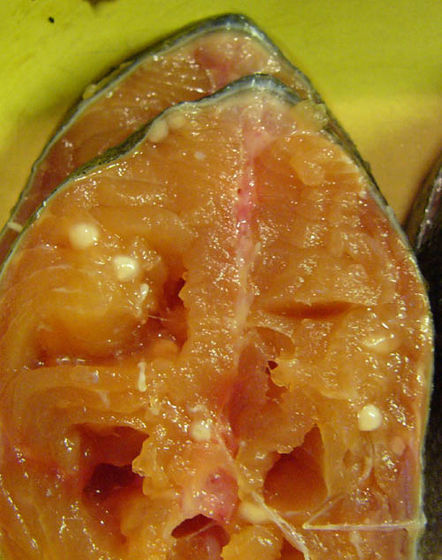`` Animals that do not need to breathe '' are found from unexpectedly close places

by Stephen Douglas Atkinson
Oxygen is a substance that most animals and plants on earth, including humans, need for breathing. Oxygen-free creatures include
A cnidarian parasite of salmon (Myxozoa: Henneguya) lacks a mitochondrial genome | PNAS
https://www.pnas.org/content/early/2020/02/18/1909907117
Scientists discover first known animal that doesn't breathe | Live Science
https://www.livescience.com/first-non-breathing-animal.html
Scientists Find The First-Ever Animal That Doesn't Need Oxygen to Survive
https://www.sciencealert.com/this-is-the-first-known-animal-that-doesn-t-need-oxygen-to-survive

Scientists accidentally discover first 'animal' that doesn't breathe oxygen-CNET
When salmon and trout are infected with a parasite called Henneguya Salminicola , fisheries officials call these spots ' tapioca disease ' because milky white spots can be seen on the surface of the fillets. The fish meat affected by tapioca disease has not been of particular interest because, although it looks bad, it is harmless to eat by humans and animals.

by
The research group of zoologist Dayana Yahalomi and others at Tel Aviv University in Israel has found that such Henegaya Salmini Kola has a surprising secret. Initially, Yahalomi and colleagues attempted to analyze the mitochondrial DNA of H. salmonicola to find out how it respires in the low-oxygen situation of the 'salmon body.' Researchers tried to analyze mitochondrial DNA because mitochondria are essential organs of cells of organisms including humans that breathe oxygen, but even when examined repeatedly, organs similar to mitochondria can be found. Although found, mitochondrial DNA could not be extracted.

When the troubled research group examined the parasite (
Without mitochondria, it is impossible to breathe using oxygen, so it is unknown how Henegaya Salminicora lives, but according to Dorothée Huchon, co-author of the paper, `` Using a special protein, adenosine from the host It is possible that they steal triphosphate (ATP) and use it as an energy source. ' ATP is a substance that is created during the process by which cells generate energy through respiration. It plays an important role in the metabolism and synthesis of substances in the living body, and is therefore sometimes referred to as the 'biological energy currency.'

by Stephen Douglas Atkinson
In addition, such as Huchon said, 'Henegaya-Saruminikora myxozoa fellow, because it has a minimum size of DNA in the animal kingdom, it is possible to breed efficiently. As a result, a relatively harmless Henegaya-Saruminikora And similar parasites have been able to infect most marine fish. '
The group noted in our paper, 'Our findings show that not only unicellular eukaryotes, but also multicellular organisms and parasites have adapted and evolved to an oxygen-free anaerobic environment. You can see how organisms evolve from an aerobic environment to a strictly anaerobic metabolism. '
Related Posts:







